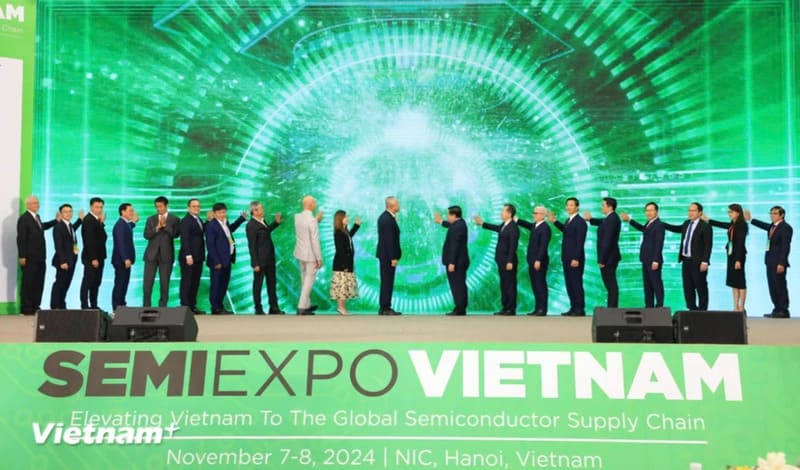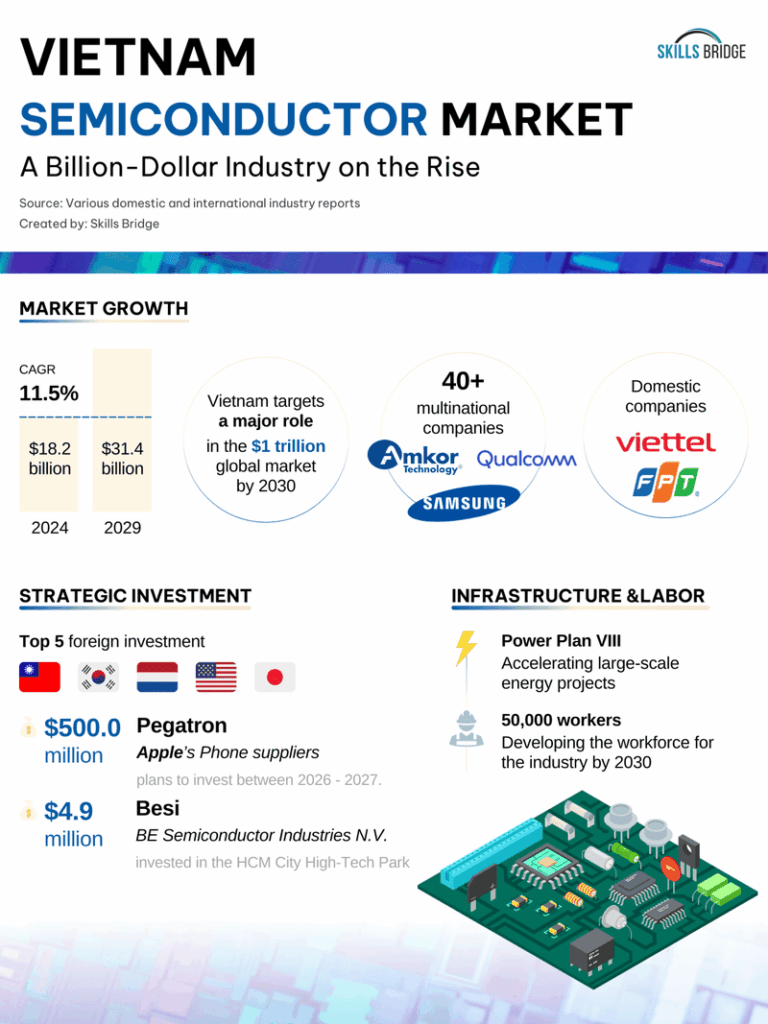The semiconductor industry is at the heart of global technological innovation, powering everything from smartphones to advanced AI systems. Vietnam, with its strategic location and growing industrial capabilities, is emerging as a critical player in this global ecosystem. In this article, we explore the current state, opportunities, and challenges of Vietnam’s semiconductor industry in 2024 and beyond, and why it holds promise as a key hub in Southeast Asia.
Introduction to Vietnam’s Semiconductor Industry
The semiconductor industry is a cornerstone of modern technology, driving advancements in computing, telecommunications, automotive, and more. Vietnam is poised to capitalize on the global demand for semiconductors, leveraging its geographical advantages and increasing investments in high-tech industries.
The semiconductor sector has grown exponentially worldwide, driven by innovations in AI, IoT, and 5G. In Vietnam, this growth aligns with the country’s ambitions to become a global tech manufacturing hub. Semiconductors are vital components in a wide range of devices, underscoring their importance in the digital age.
Vietnam has rapidly positioned itself as a rising hub for semiconductor manufacturing and assembly. As companies diversify their supply chains away from traditional centers like China, Vietnam is attracting significant foreign direct investments (FDI). This shift presents a golden opportunity for Vietnam to establish itself as a critical link in the global semiconductor value chain.
Current Status of Vietnam’s Semiconductor Industry (2024)
Vietnam’s semiconductor industry is experiencing remarkable growth, driven by increasing global demand, supportive government policies, and strategic investments. Below, we examine the sector’s current market size and the key players shaping its landscape.

SEMIExpo Vietnam 2024 launched on November 7 (Photo: VietnamPlus)
Market Size and Growth Potential
Vietnam’s semiconductor market is projected to reach $7 billion by 2028, according to VietnamNet. This growth is fueled by several factors:
- Rising demand for semiconductors: Driven by advancements in AI, IoT, and other high-tech applications.
- Government incentives: Tax breaks and subsidies aimed at attracting investments in high-tech manufacturing.
- Global supply chain shifts: Companies are relocating operations to Vietnam to diversify their production bases and mitigate geopolitical risks.
Major global tech companies are investing heavily in Vietnam’s semiconductor sector. The establishment of high-value projects, such as the $1.6 billion Samsung R&D center in Hanoi, exemplifies this trend. Additionally, Vietnam is benefiting from FDI inflows from countries like Japan, South Korea, and the US, further bolstering its semiconductor capabilities.

(Vietnam Semiconductor Market: A Billion-Dollar Industry on the Rise)
Opportunities for the Semiconductor Industry in 2025
Vietnam’s semiconductor sector holds immense potential for growth in 2025, bolstered by strategic advantages, emerging technological trends, and export opportunities.
Vietnam’s Strategic Advantages
Vietnam’s proximity to global technology hubs like China, Taiwan, and South Korea makes it an attractive destination for semiconductor manufacturing. Coupled with government policies promoting high-tech industries, the country is well-positioned to attract more investments in the sector.
Key initiatives include tax incentives, infrastructure development, and technology transfer agreements with leading global firms.
Emerging Trends
Technological advancements are shaping the future of Vietnam’s semiconductor industry:
- AI and IoT adoption: The growing use of AI and IoT technologies drives demand for advanced semiconductors.
- 5G networks: With the rollout of 5G, the need for high-speed, high-performance chips will increase exponentially.
- Semiconductor testing and packaging: Vietnam has the potential to become a global leader in these critical areas of the semiconductor value chain.
Potential for Export Growth
Vietnam’s expanding semiconductor production opens up lucrative export opportunities to major markets like the US, EU, and Japan. With its competitive labor costs and growing expertise, Vietnam can cater to global demand while establishing itself as a trusted supplier.
Challenges Facing Vietnam’s Semiconductor Industry
Despite its potential, Vietnam’s semiconductor sector faces significant challenges that could hinder its growth.
Talent Shortages
The shortage of skilled engineers and technicians remains a pressing issue. Vietnam’s education system has not yet fully aligned with the demands of high-tech industries, creating a gap between workforce capabilities and industry needs.
Supply Chain Dependencies
Vietnam heavily relies on imported raw materials and advanced manufacturing equipment, which makes its semiconductor industry vulnerable to global supply chain disruptions. This dependency also increases production costs and limits local value addition.

Competition
Vietnam faces stiff competition from established semiconductor powerhouses like China, South Korea, and Taiwan. These countries have more mature ecosystems, deeper expertise, and greater economies of scale.
Solutions to Drive Growth in Vietnam’s Semiconductor Sector
To overcome these challenges and capitalize on its opportunities, Vietnam must implement strategic measures across policy, workforce development, and supply chain enhancement.
Policy Support
The government can strengthen the sector by offering tax incentives, R&D grants, and subsidies to attract global semiconductor firms. Partnerships with technology leaders can facilitate knowledge transfer and boost domestic capabilities.
Workforce Development
Investing in education and training programs is crucial to address the talent gap. Collaborations between universities and industry players can help develop specialized curricula, while scholarships and exchange programs can nurture future talent.

Strengthening Supply Chains
Encouraging local suppliers to participate in the semiconductor ecosystem will reduce dependency on imports. Investments in R&D can also enhance Vietnam’s ability to produce raw materials and components domestically, fostering a more self-reliant supply chain.
Conclusion
Vietnam’s semiconductor industry is on the brink of transformative growth, fueled by strategic investments, government support, and global demand. While challenges such as talent shortages and supply chain dependencies remain, targeted solutions can help Vietnam establish itself as a key player in the global semiconductor market.
Thông tin Triển lãm giao thương ngành chế tạo lần thứ 9 – FBC ASEAN 2025:
Triển lãm FBC ASEAN 2025 dành cho các doanh nghiệp và cá nhân ngành chế tạo
1. Thái Lan:
- Thời gian: 14 – 17/05/2025 (9h00 – 17h00)
2. Hà Nội:
- Thời gian: 17 – 19/09/2025 (9h00 – 17h00)
- Địa điểm: Trung tâm Triển lãm Quốc tế I.C.E Hà Nội (91 Trần Hưng Đạo, Hoàn Kiếm, Hà Nội)
3. Online:
- Thời gian: 08 – 10/10/2025
- Nền tảng trực tuyến.
Fanpage FBC Việt Nam: https://www.facebook.com/factory.business.expo.vn




